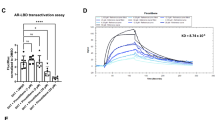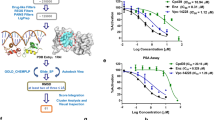Abstract
Prostate cancer usually develops to a hormone-refractory state that is irresponsive to conventional therapeutic approaches. Therefore, new methods for treating aggressive prostate cancer are under development. Because of the importance of androgen receptors (ARs) in the development of the hormone-refractory state and AR mechanism of action, this study was designed. A single-stranded DNA as an aptamer was designed that could mimic the hormone response element (HRE). The LNCaP cells as an AR-rich model were divided into three sets of triplicate groups: the test group was transfected with Aptamer Mimicking HRE (AMH), Mock received only transfection reagents (mock) and a negative control. All three sets received 0, 10 and 100 nM of dehydroepiandrosterone (DHEA) separately. Data analysis showed hormone dependency of LNCaP cells in the negative control group upon treatment with 10 and 100 nM DHEA (compared with cells left untreated (P=0.001)). Transfection of AMH resulted in significant reduction of proliferation in the test group when compared with the negative control group with 10 (P=0.001) or 100 nM DHEA (P=0.02). AMH can form a hairpin structure at 37 °C and mimic the genomic HRE. Hence, it is capable of effectively competing with genomic HRE and interrupting the androgen signaling pathway in a prostate cancer cell line (LNCaP).
This is a preview of subscription content, access via your institution
Access options
Subscribe to this journal
Receive 12 print issues and online access
$259.00 per year
only $21.58 per issue
Buy this article
- Purchase on Springer Link
- Instant access to full article PDF
Prices may be subject to local taxes which are calculated during checkout




Similar content being viewed by others
References
Torre LA, Bray F, Siegel RL, Ferlay J, Lortet-Tieulent J, Jemal A . Global cancer statistics, 2012. CA Cancer J Clin 2012; 65: 87–108.
Siegel RL, Miller KD, Jemal A . Cancer statistics, 2015. CA Cancer J Clin 2015; 65: 5–29.
Wallace TJ, Torre T, Grob M, Yu J, Avital I, Brucher B et al. Current approaches, challenges and future directions for monitoring treatment response in prostate cancer. J Cancer 2014; 5: 3–24.
Gann PH . Risk factors for prostate cancer. Rev Urol 2002; 4 (Suppl 5): S3–S10.
Chang AJ, Autio KA, Roach M 3rd, Scher HI . High-risk prostate cancer-classification and therapy. Nat Rev Clin Oncol 2014; 11: 308–323.
Marciscano A, Hardee M, Sanfilippo N . Management of high-risk localized prostate cancer. Adv Urol 2012; 2012: 641689.
Graff JN, Chamberlain ED . Sipuleucel-T in the treatment of prostate cancer: an evidence-based review of its place in therapy. Core Evid 2015; 10: 1–10.
Knudsen KE, Scher HI . Starving the addiction: new opportunities for durable suppression of AR signaling in prostate cancer. Clin Cancer Res 2009; 15: 4792–4798.
Lonergan PE, Tindall DJ . Androgen receptor signaling in prostate cancer development and progression. J Carcinog 2011; 10: 20.
Laffitte BA, Kast HR, Nguyen CM, Zavacki AM, Moore DD, Edwards PA . Identification of the DNA binding specificity and potential target genes for the farnesoid X-activated receptor. J Biol Chem 2000; 275: 10638–10647.
Haelens A, Verrijdt G, Callewaert L, Peeters B, Rombauts W, Claessens F . Androgen-receptor-specific DNA binding to an element in the first exon of the human secretory component gene. Biochem J 2001; 353: 611–620.
Kim YS, Gu MB . Advances in aptamer screening and small molecule aptasensors. Adv Biochem Eng Biotechnol 2014; 140: 29–67.
Song KM, Lee S, Ban C . Aptamers and their biological applications. Sensors (Basel) 2012; 12: 612–631.
Diafa S, Hollenstein M . Generation of aptamers with an expanded chemical repertoire. Molecules 2015; 20: 16643–16671.
Wang Y, Luo Y, Bing T, Chen Z, Lu M, Zhang N et al. DNA aptamer evolved by cell-SELEX for recognition of prostate cancer. PLoS One 2014; 9: e100243.
He X, Chen J, Yie SM, Ye SR, Dong DD, Li K . Using a sequence of estrogen response elements as a DNA aptamer for estrogen receptors in vitro. Nucleic Acid Ther 2015; 25: 152–161.
Chaturvedi S, Garcia JA . Novel agents in the management of castration resistant prostate cancer. J Carcinog 2014; 13: 5.
Schroder FH . Progress in understanding androgen-independent prostate cancer (AIPC): a review of potential endocrine-mediated mechanisms. Eur Urol 2008; 53: 1129–1137.
Li MT, Richter F, Chang C, Irwin RJ, Huang H . Androgen and retinoic acid interaction in LNCaP cells, effects on cell proliferation and expression of retinoic acid receptors and epidermal growth factor receptor. BMC Cancer 2002; 2: 16.
Devlin HL, Mudryj M . Progression of prostate cancer: multiple pathways to androgen independence. Cancer Lett 2009; 274: 177–186.
Pickard MR, Mourtada-Maarabouni M, Williams GT . Long non-coding RNA GAS5 regulates apoptosis in prostate cancer cell lines. Biochim Biophys Acta 2013; 1832: 1613–1623.
De Schrijver E, Brusselmans K, Heyns W, Verhoeven G, Swinnen JV . RNA interference-mediated silencing of the fatty acid synthase gene attenuates growth and induces morphological changes and apoptosis of LNCaP prostate cancer cells. Cancer Res 2003; 63: 3799–3804.
Deezagi A, Ansari-Majd S, Vaseli-Hagh N . Induced apoptosis in human prostate cancer cells by blocking of vascular endothelial growth factor by siRNA. Clin Transl Oncol 2012; 14: 791–799.
Liao X, Tang S, Thrasher JB, Griebling TL, Li B . Small-interfering RNA-induced androgen receptor silencing leads to apoptotic cell death in prostate cancer. Mol Cancer Ther 2005; 4: 505–515.
Fletcher CE, Dart DA, Sita-Lumsden A, Cheng H, Rennie PS, Bevan CL . Androgen-regulated processing of the oncomir miR-27a, which targets prohibitin in prostate cancer. Hum Mol Genet 2012; 21: 3112–3127.
Folini M, Gandellini P, Longoni N, Profumo V, Callari M, Pennati M et al. miR-21: an oncomir on strike in prostate cancer. Mol Cancer 2010; 9: 12.
Acknowledgements
We would like to thank Ilnaz Rahimmanesh and Ariel Morris for their kind collaboration.
Author information
Authors and Affiliations
Corresponding author
Ethics declarations
Competing interests
The authors declare no conflict of interest.
Rights and permissions
About this article
Cite this article
Kouhpayeh, S., Einizadeh, A., Hejazi, Z. et al. Antiproliferative effect of a synthetic aptamer mimicking androgen response elements in the LNCaP cell line. Cancer Gene Ther 23, 254–257 (2016). https://doi.org/10.1038/cgt.2016.26
Received:
Revised:
Accepted:
Published:
Issue Date:
DOI: https://doi.org/10.1038/cgt.2016.26
This article is cited by
-
Generation of HBsAg DNA aptamer using modified cell-based SELEX strategy
Molecular Biology Reports (2021)



